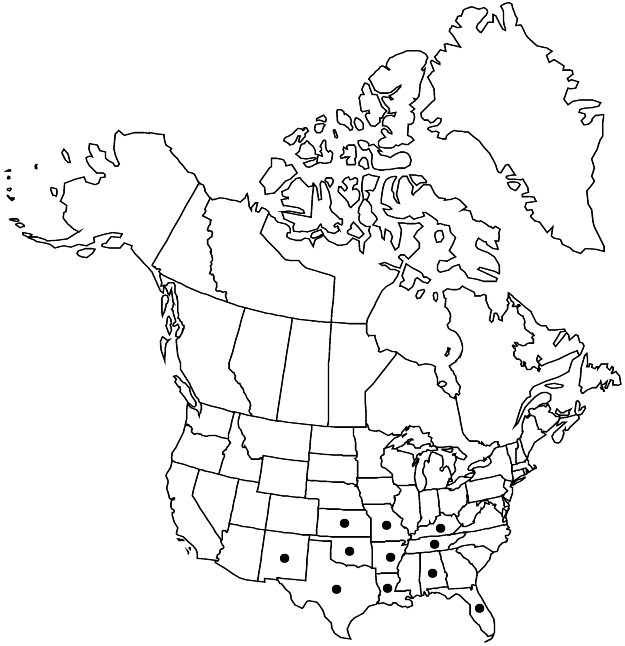Difference between revisions of "Eriogonum longifolium"
Trans. Amer. Philos. Soc., n. s. 5: 164. 1835.
RevisionBot (talk | contribs) m (Bot: Adding category Revision Pending) |
imported>Volume Importer |
||
| Line 6: | Line 6: | ||
|place=5: 164. 1835 | |place=5: 164. 1835 | ||
|year=1835 | |year=1835 | ||
| + | }} | ||
| + | |special_status={{Treatment/ID/Special_status | ||
| + | |code=W | ||
| + | |label=Weedy | ||
| + | }}{{Treatment/ID/Special_status | ||
| + | |code=F | ||
| + | |label=Illustrated | ||
| + | }}{{Treatment/ID/Special_status | ||
| + | |code=E | ||
| + | |label=Endemic | ||
}} | }} | ||
|basionyms= | |basionyms= | ||
| Line 19: | Line 29: | ||
-->{{Treatment/Body | -->{{Treatment/Body | ||
| − | |distribution= | + | |distribution=Ala.;Ark.;Fla.;Kans.;Ky.;La.;Mo.;N.Mex.;Okla.;Tenn.;Tex. |
|discussion=<p>Varieties 3 (3 in the flora).</p> | |discussion=<p>Varieties 3 (3 in the flora).</p> | ||
|tables= | |tables= | ||
| Line 57: | Line 67: | ||
|basionyms= | |basionyms= | ||
|family=Polygonaceae | |family=Polygonaceae | ||
| − | |distribution= | + | |distribution=Ala.;Ark.;Fla.;Kans.;Ky.;La.;Mo.;N.Mex.;Okla.;Tenn.;Tex. |
|reference=None | |reference=None | ||
|publication title=Trans. Amer. Philos. Soc., n. s. | |publication title=Trans. Amer. Philos. Soc., n. s. | ||
|publication year=1835 | |publication year=1835 | ||
| − | |special status= | + | |special status=Weedy;Illustrated;Endemic |
| − | |source xml=https:// | + | |source xml=https://bitbucket.org/aafc-mbb/fna-data-curation/src/2e0870ddd59836b60bcf96646a41e87ea5a5943a/coarse_grained_fna_xml/V5/V5_667.xml |
|subfamily=Polygonaceae subfam. Eriogonoideae | |subfamily=Polygonaceae subfam. Eriogonoideae | ||
|genus=Eriogonum | |genus=Eriogonum | ||
| Line 69: | Line 79: | ||
}}<!-- | }}<!-- | ||
| − | --> | + | -->[[Category:Treatment]][[Category:Eriogonum subg. Eriogonum]] |
| − | |||
| − | [[Category:Treatment]] | ||
| − | [[Category:Eriogonum subg. Eriogonum | ||
| − | |||
Revision as of 22:12, 5 November 2020
Herbs, 3–20 × 1.5–8 dm, tomentose or nearly glabrous. Aerial flowering stems erect, 2–17 dm, occasionally finely striated or grooved. Leaves: petiole 5–20 cm; blade lanceolate or oblanceolate to oblong, 0.5–20 × 0.3–2.5(–3) cm, tomentose abaxially, less so to floccose or glabrous adaxially. Inflorescences 5–50(–80) × 5–50 cm; bracts 3, scalelike, usually triangular, 1–5 mm. Peduncles 0.3–3 cm, thinly tomentose or nearly glabrous. Involucres turbinate to campanulate, 3–7 × 1.5–6 mm; teeth 0.2–0.8 mm. Flowers 5–15 mm, including (0.5–)1–4(–7) mm stipelike base; perianth yellow, densely white- to silvery-tomentose abaxially; tepals monomorphic, lanceolate to narrowly elliptic; stamens 1.7–2.5 mm; filaments glabrous. Achenes brown, 4–6 mm, densely tomentose.
Distribution

Ala., Ark., Fla., Kans., Ky., La., Mo., N.Mex., Okla., Tenn., Tex.
Discussion
Varieties 3 (3 in the flora).
Selected References
None.
Lower Taxa
Key
| 1 | Flowers 8-15 mm, including 2-4(-7) mm stipelike base; involucres 6-7 mm; c Florida | Eriogonum longifolium var. gnaphalifolium |
| 1 | Flowers 5-11 mm, including 0.5-2.5 mm stipelike base; involucres 3-6 mm; not of c Florida | > 2 |
| 2 | Involucres 4-6 mm; flowers 5-11 mm, including (0.5-)1-2.5 mm stipelike base; s Arkansas, s Kansas, wc Louisiana, sw Missouri, se New Mexico, Oklahoma, Texas | Eriogonum longifolium var. longifolium |
| 2 | Involucres 3-3.5 mm; flowers 5-7 mm, including 0.5-1(-1.2) mm stipelike base; nw Alabama, c Kentucky, sc Tennessee | Eriogonum longifolium var. harperi |